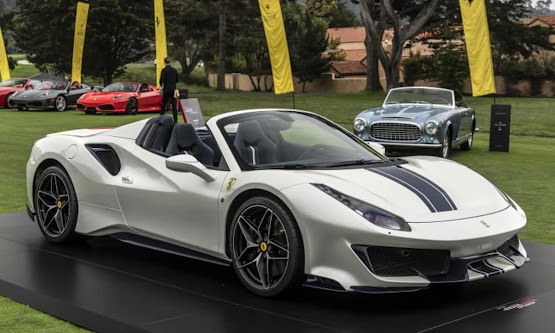Cravat (pronounced kruh-vat)
(1) A cloth, usually of wool or silk and trimmed with
lace, worn about the neck by men; especially popular in the seventeenth century.
(2) A decorative fabric band or scarf worn around the
neck by women (obsolete).
(3) In modern use, a type of necktie worn by men, having long
ends hanging in front, the most elaborate form of which is the “dress cravat”, “Ascot
band” or “Ascot tie”.
(4) In medicine, a bandage made by folding a triangular
piece of material into a band, used temporarily for a fracture or wound.
(5) As “hempen cravat” a euphemism for the hangman’s noose
(hemp a fibre used to make rope.
1650-1660: From the French cravate, an appellative use of the French Cravate (Croat), from the Dutch Krawaat,
from the German Krawatte, from the Serbo-Croatian/Хр̀ва̄т (Hr̀vāt) (Croat). The name was adopted because
the neck adornments were worn by Croatian mercenaries serving in the French
army during the Thirty Years' War and was quickly absorbed into French fashion. Cravat is a noun, cravatting is a verb and cravatted
is an adjective (both verb & adjective are now rare); the noun plural is
cravats.
Military influences in fashion are not unknown and cravats
came into fashion in France in the mid-seventeenth century in imitation of
linen scarves worn by the Crabats, formations
of light cavalry forces which as mercenaries were attached to forces which fought
on the side of the Catholic League in the Thirty Years' War (1618-1648). The word cravates
in French meant “Croatians” and the name in this context has come to be thought
an ethnic label but in the narrow technical sense it was a generic designation of
the light cavalry from the Hapsburg Military Frontier, which included Croats,
Hungarians, Serbs, Wallachians, Poles, Cossacks and Tatars.
Methods of tying a cravat in eighteenth century France,
When first it came into use in French fashion, it was
commonly made of lace & linen or muslin edged with lace, the long flowing
ends tied in a variety of ways and it has evolved, the modern cravat more of a necktie,
passed once round the neck, and tied in front in a bow although in popular
culture one of the most popular depictions seems to be the style popular in the early-mid nineteenth century: a triangular silk kerchief (usually black), wrapped
twice round the neck, in imitation of the stock; prior to that, starched linen cravats were
worn by gentlemen (an those aspiring to be thought one) and a perfectly tied
example was thought one of the markers of the class. The cravat differs from the scarf which,
whether tied, passed through a ring, or held by a pin, hangs down over the
shirt front and in some ways is functionally similar to a muffler.
Like many of the symbols of civilizations associated with
Europe, the cravat’s antecedents lie to the east, similar arrangements in cloth
used as signifiers of high social status in both Ancient Egypt and China while
in the art of the Rome of Antiquity, there are many depictions of jewels and
other decorative constructions appearing around the neck which strikingly
resemble the later cravats. Throughout
Europe too, a scarf around the neck was an old custom and part of the costumes
of many European nations, worn in all climates although those in colder places
were obviously thicker and often purely functional. The tied scarf was well known as a visible
part of national costumes in various Croatian provinces: In Omišalj it was the facol (which the Ancient Romans called
the focale), in Baranja in the east it was the poša, and in the north the rubec. Cultural anthropologists trace the earliest
know reference to such garments in the region to the area surrounding of the
village of Turopolje where they were known as podgutnica or podgutnjak.
The legend is that girls and women would give their scarves to boyfriends and husbands going to war and when tied around their necks, they represented ownership papers by which a man would display his loyalty. This apparently did happen in some villages but seems not to have been a national tradition and quite how long a young man’s promise of fidelity lasted once the troops had marched isn’t known but the idea proved useful to military commanders who came to value a distinctive scarf as a way of distinguishing one soldier from another in the clatter of battle. Europe being for centuries a blood-soaked place, the black and red colors of the Croatian scarfs became well-known on European battlefields because the Croats were highly-valued mercenaries in the Habsburg, Bavarian, Spanish, Danish and French armies, noted for their efficiency, innovations in tactic and tight discipline. Napoleon Bonaparte (1769–1821), a fair judge of such things, said more than once “I never had more braver and better soldiers. Croats, they are the best soldiers in the world. If I had only 100,000 Croats, I would conquer the entire world!”
Chanel jacket with cravat.
At the time, the scarves worn by the military were called podgutnjak or podgutnica and mode of different materials ranging from the rough linen or wool items of ordinary soldiers, to the fine silk and cotton-wool of officers. Whatever the construction, it quickly was adapted to become a functional piece of military kit which served purposes beyond identification because, attached to the neck by knot it also fulfilled the basic purpose of holding the rest of the clothes together, something vital in close combat. Tied around the neck, it protected against cold and could be used to cover the lips, preventing dust from coming into his mouth while in the heat, it was protection from the sun and a rag with which to wipe away sweat. Usefully too, the fabric protected a soldier’s neck from irritation, insect bites or scratches from rough military clothing (something which was quickly understood by fighter pilots in the Battle of Britain (1940) who soon discarded collars and ties for silk scarves) and for soldiers on horseback, silk in particular proved its worth in deflecting sabre strikes. Finally, the scarf served also a tourniquet or field dressing.
The cavalry must have been a dashing sight because before the
mid-seventeenth century the custom of the knotted scarf around the neck was unknown
urban Europe and it was the acceptance and rapid adoption by the French court which
lent the sartorial innovation the respectability needed for it to become a
fashionable garment among the nobility. They
phrase at the time was a la Croate (in
the Croatian way) which was the root of the French word cravate and such was the impression made that in 1643 a special
regiment of Royal Cravates was formed, named after the Croats who were in its ranks,
the first cravat officially presented in 1656.
Despite the military origins, the cravat eventually became a symbol of
progress in France and during the French Revolution a black tie was worn as a sign
of protest against backward, outdated ideas. From there, although revolution was suppressed,
the ties spread to the Belgians, the Dutch and the English and Charles II
(1630–1685; King of Scotland 1649-1651, King of England, Scotland and Ireland
1660-1685), upon on his return from exile uttered the words “Bring me a tie or I shall die”.
Donald Trump (b 1946; US president 2017-2021) with Boris Johnson (b 1964; UK prime-minister 2019-2022) (left) & Benjamin Netanyahu (b 1949; Israeli prime-minister 1996-1999, 2009-2021 & probably soon again) (right). Fashionistas derided Donald Trump for his extravagantly long ties; he ignored them and does seem to have influenced the easily-led.
After this, the cravat became a cult and eventually a tie
(the word derived from “to tie a cravat”). The English had first favored white but as
technology made things possible, colors and patterns became popular but in the
nineteenth century, it was the Americans who made the notable structural change
of cutting the fabric in three parts, then sewing them together, the advantage
being they became both cheaper to produce and easier to tie. According to two researchers from the
University of Cambridge, theoretically there are 85 possible ways to bind a standard
tie knot, assuming the number of “moves” is limited to nine (and it’s a scandal
no Ignoble Prize was won for determining this). One
particular interesting finding which emerged from the mathematical modeling was
that of the seven-dozen odd, only ten knots corresponded to conventional
symmetry although most used with the modern tie are symmetrical including the plain
knot, the double knot, the small knot, the classic Windsor, the semi-Windsor,
the Albert knot and the American knot.
One convention is that ties should not be too long, something more-or-less
observed until Donald Trump decided to pay tribute to the codpiece. Ties of late have fallen from favor in the
west although the Japanese remain big buyers, the uniform of the salaryman
apparently still a lure and for those who wish to mark the tradition, international
cravat day (Hrvatska in Croatian) is celebrated annually on 18 October.
Portrait of Ivan Gundulić (Dživo Franov Gundulić or Gianfrancesco Gondola in the Italian) (1589-1638), circa 1622-1630, oil on canvas by an unknown artist. The most prominent of the Baroque poets from the Republic of Ragusa (now in modern-day Croatia), Gundulić is regarded as the Croatian national poet and this portrait is the oldest known image of a man wearing a cravatte (cravat).
Noted Instagram influencer, German-born Ivana Knoll (b 1992) was a finalist in the Miss Croatia competition in 2016 and the best-known fan to appear at the 2022 FIFA World Cup in Qatar, always attired in a variety of outfits using the Croatian national symbol of the red and white checkerboard, matching the home strip worn by the team. Her outfits were much admired and she was a popular accessory sought by Qatari men for their selfies but she missed an opportunity by not including a checkered cravat which, if strategically tied to drape in just the right way, would have been most photogenic.























